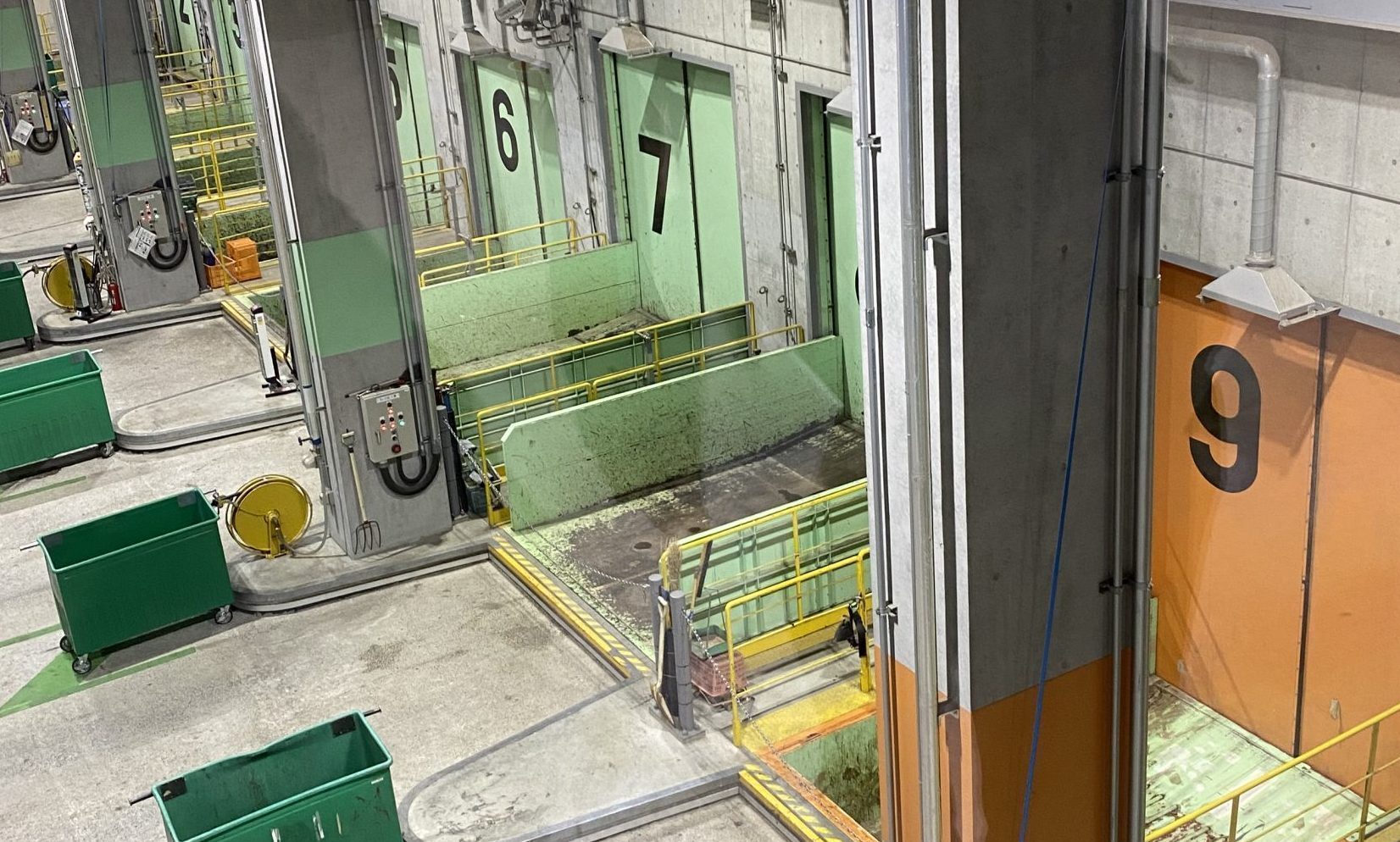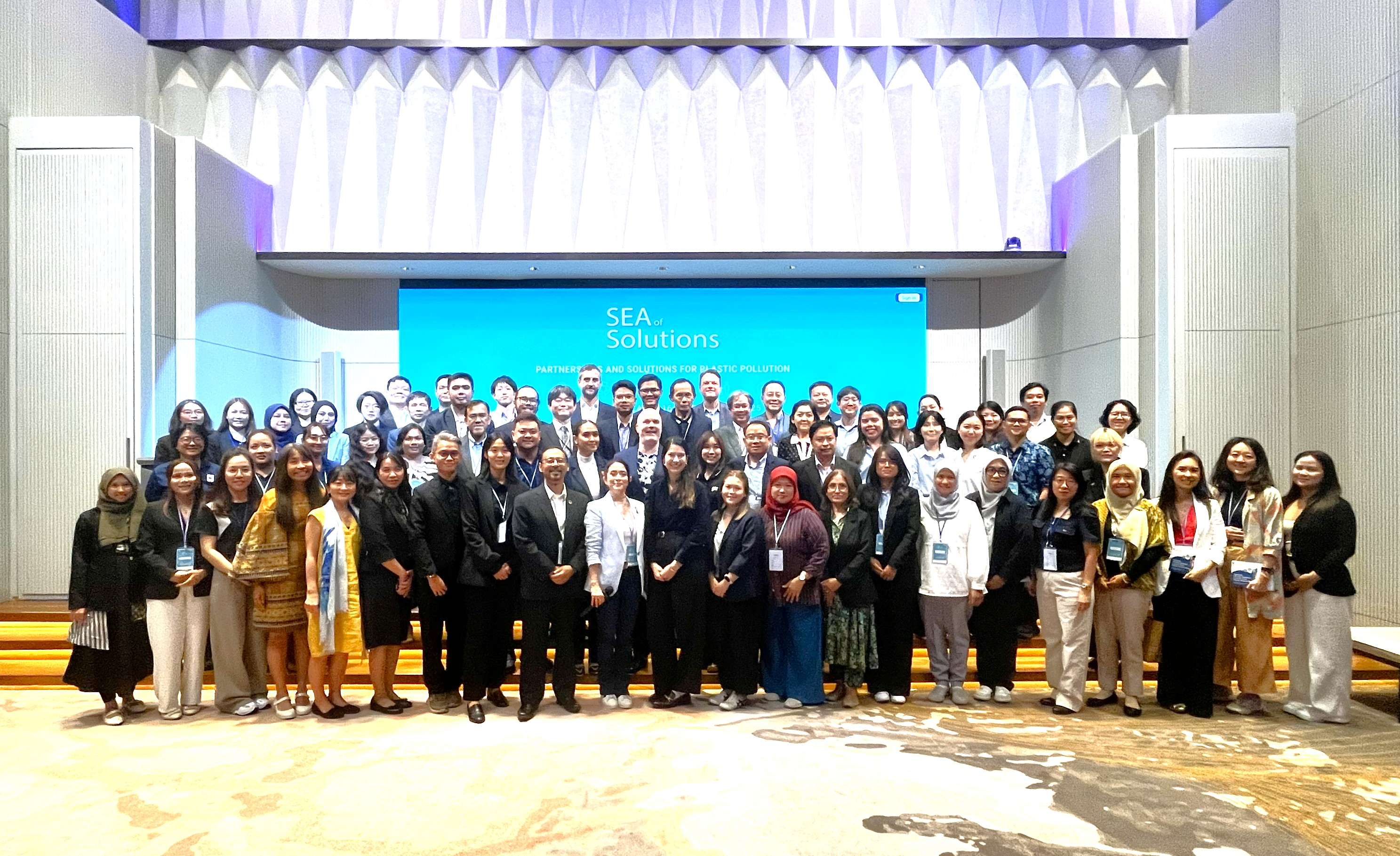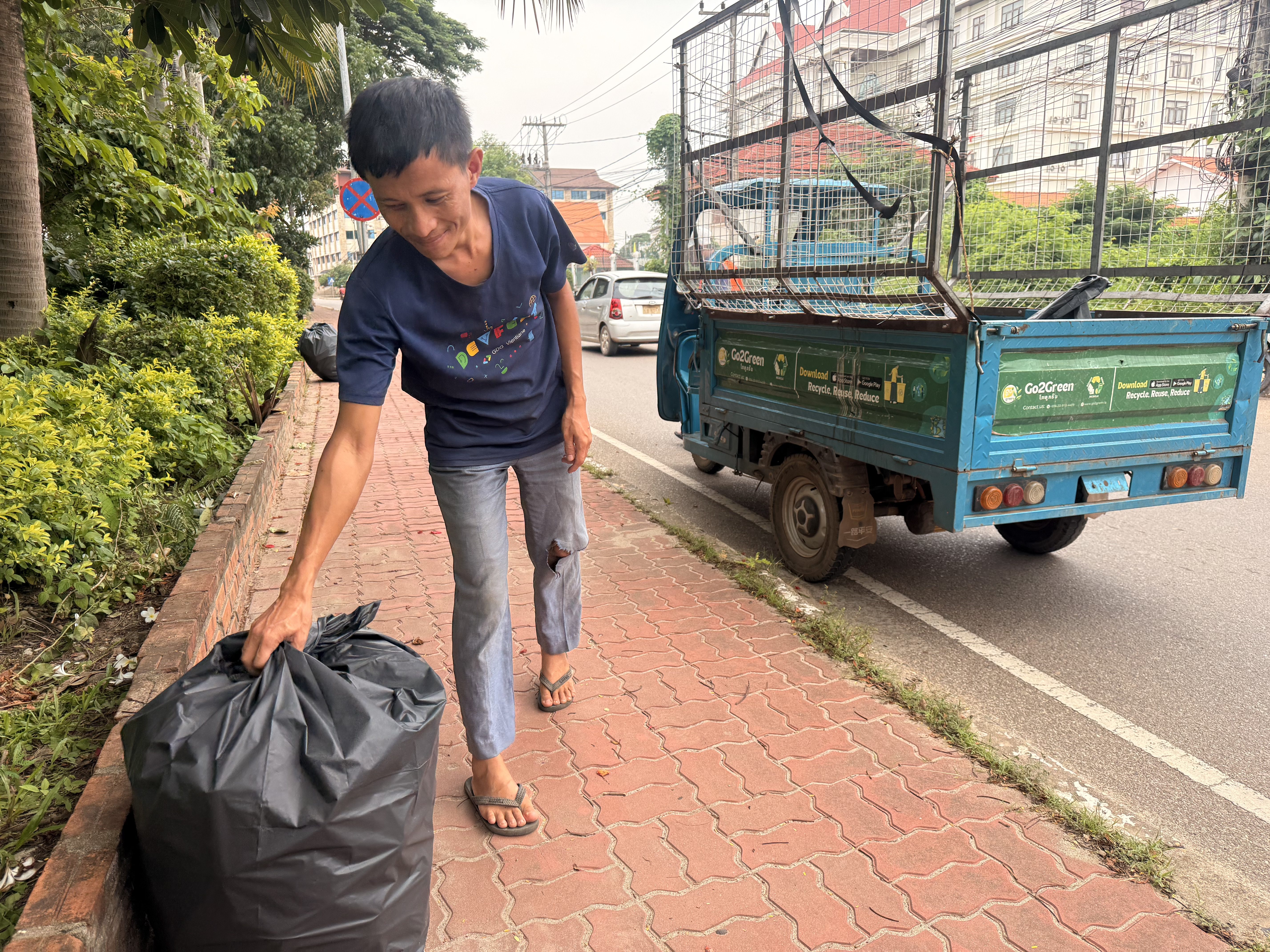

Kyoto, 18 March 2023: On the sidelines of the 3R (Reduce, Reuse, Recycle) International Scientific Conference on Material Cycles and Waste Management (3RINCs) 2023, a team from the Regional Knowledge Centre for Marine Plastic Debris (the Centre) visited Kyoto South Clean Centre Plant No 2 in Fushimi ward, to learn how the city manages its waste. The plant has several facilities, including waste sorting, waste incineration, biogasification, and the Sustaina Kyoto environmental education facility.
‘The whole plant was funded by the government of Kyoto, except for the biogasification facility, which was partly funded by the national government,' said Mr Kazuki Hirota, our tour guide from Kyoto University.
Waste Sorting
Waste sorting is a fundamental step for the entire process as it is where everything begins. To feed the incinerator, waste comes into the plant through different coloured doors, as shown in the above photograph. Large size waste comes through the green doors; while pliable waste such as futons, tatami mats, and carpets comes through the orange doors. The sizable waste is then shredded by a high-speed rotary shredder. In this process, iron, aluminium, and copper particles are separated with the help of the sorters. The pliable waste is then cut by hydraulically operated blades before being fed into the incinerator.
Waste Incineration
Waste to energy works by turning waste into electricity by producing heat through incineration. Firstly, shredded waste from the waste sorting facility is fed into the incinerator furnace with a minimum temperature of 9,000C.
The generated heat boils water to produce high-pressure steam which moves the turbines, which in turn generate electricity up to 14,000 kW. Some of this electricity is used to run the plant facilities, and the rest is sold to the power company. Overall, the electricity generated from the plant is capable of powering 22,000 households/year.
Figure 3. The officer from the Kyoto South Clean Center Plant No. 2 showing the illustration of the heat inside the furnace
To control air pollution, the incineration facility is supported by specialist equipment such as bag filters to remove fine dust and dioxins from the exhaust gas; an activated carbon adsorption tower to adsorb and remove harmful substances; a wet gas scrubber to remove the sulphur oxides, hydrogen chloride, and other substances; and a denitration reaction tower to blow ammonia into the exhaust gas to decompose nitrogen oxide and nitrogen.
The incinerator is equipped with a dust treatment facility and ash crane to manage the ash/dust. The dust generated during the waste to energy process is first collected by the bag filter in the dust treatment facility and stabilised with chemicals. The collected dust is then loaded into ash trucks by the ash crane.
Biogasification
Biogasification also turns waste into energy, but what makes it different is that the facility uses organic materials such as food waste to produce biogas to generate electricity.
Firstly, the organic materials are extracted from general waste using pre-treatment equipment – a shredder and a bag breaker to break down the waste into suitable size for fermentation, as well as sorting tools to remove the non-suitable waste. The organic waste is then sent to the methane fermentation tank, where microorganisms decompose it into biogas, mainly methane. The methane is then temporarily stored in the gas holder before being used to power the generator and produce electricity. The generator can produce up to 1,000 kW annually, enough to power 2,000 households.
Sustaina Kyoto Environmental Education Facility
Sustaina Kyoto is a public open space where visitors can learn about the waste to energy process. Visitors can take a tour to observe the waste to energy supporting facilities, such as the incinerator, fermentation tank, and control room.
During the tour, visitors are introduced to Do You Kyoto?, a campaign catchphrase encouraging people to take positive actions for the environment. The campaign promotes an environmentally friendly lifestyle, such as substituting plastic bags for reusable bags/tote bags, segregating household waste, and preventing littering.
Panels with information related to the Kyoto Environmental Report are on display on the facility's ground floor. This information includes solid waste data such as 399 gram/day/person, and food loss in Kyoto reaching 5,700 tons/year, along with the city's target to reduce its greenhouse gas emissions by 40% in 2030.
‘The waste generation in Kyoto tends to peak in December because it is holiday time and people usually clean their houses’, said Mr Hirota.
Kyoto, 18 March 2023: On the sidelines of the 3R (Reduce, Reuse, Recycle) International Scientific Conference on Material Cycles and Waste Management (3RINCs) 2023, a team from the Regional Knowledge Centre for Marine Plastic Debris (the Centre) visited Kyoto South Clean Centre Plant No 2 in Fushimi ward, to learn how the city manages its waste. The plant has several facilities, including waste sorting, waste incineration, biogasification, and the Sustaina Kyoto environmental education facility.
‘The whole plant was funded by the government of Kyoto, except for the biogasification facility, which was partly funded by the national government,' said Mr Kazuki Hirota, our tour guide from Kyoto University.
Waste Sorting
Waste sorting is a fundamental step for the entire process as it is where everything begins. To feed the incinerator, waste comes into the plant through different coloured doors, as shown in the above photograph. Large size waste comes through the green doors; while pliable waste such as futons, tatami mats, and carpets comes through the orange doors. The sizable waste is then shredded by a high-speed rotary shredder. In this process, iron, aluminium, and copper particles are separated with the help of the sorters. The pliable waste is then cut by hydraulically operated blades before being fed into the incinerator.
Waste Incineration
Waste to energy works by turning waste into electricity by producing heat through incineration. Firstly, shredded waste from the waste sorting facility is fed into the incinerator furnace with a minimum temperature of 9,000C.
The generated heat boils water to produce high-pressure steam which moves the turbines, which in turn generate electricity up to 14,000 kW. Some of this electricity is used to run the plant facilities, and the rest is sold to the power company. Overall, the electricity generated from the plant is capable of powering 22,000 households/year.
Figure 3. The officer from the Kyoto South Clean Center Plant No. 2 showing the illustration of the heat inside the furnace
To control air pollution, the incineration facility is supported by specialist equipment such as bag filters to remove fine dust and dioxins from the exhaust gas; an activated carbon adsorption tower to adsorb and remove harmful substances; a wet gas scrubber to remove the sulphur oxides, hydrogen chloride, and other substances; and a denitration reaction tower to blow ammonia into the exhaust gas to decompose nitrogen oxide and nitrogen.
The incinerator is equipped with a dust treatment facility and ash crane to manage the ash/dust. The dust generated during the waste to energy process is first collected by the bag filter in the dust treatment facility and stabilised with chemicals. The collected dust is then loaded into ash trucks by the ash crane.
Biogasification
Biogasification also turns waste into energy, but what makes it different is that the facility uses organic materials such as food waste to produce biogas to generate electricity.
Firstly, the organic materials are extracted from general waste using pre-treatment equipment – a shredder and a bag breaker to break down the waste into suitable size for fermentation, as well as sorting tools to remove the non-suitable waste. The organic waste is then sent to the methane fermentation tank, where microorganisms decompose it into biogas, mainly methane. The methane is then temporarily stored in the gas holder before being used to power the generator and produce electricity. The generator can produce up to 1,000 kW annually, enough to power 2,000 households.
Sustaina Kyoto Environmental Education Facility
Sustaina Kyoto is a public open space where visitors can learn about the waste to energy process. Visitors can take a tour to observe the waste to energy supporting facilities, such as the incinerator, fermentation tank, and control room.
During the tour, visitors are introduced to Do You Kyoto?, a campaign catchphrase encouraging people to take positive actions for the environment. The campaign promotes an environmentally friendly lifestyle, such as substituting plastic bags for reusable bags/tote bags, segregating household waste, and preventing littering.
Panels with information related to the Kyoto Environmental Report are on display on the facility's ground floor. This information includes solid waste data such as 399 gram/day/person, and food loss in Kyoto reaching 5,700 tons/year, along with the city's target to reduce its greenhouse gas emissions by 40% in 2030.
‘The waste generation in Kyoto tends to peak in December because it is holiday time and people usually clean their houses’, said Mr Hirota.

Research Associate



